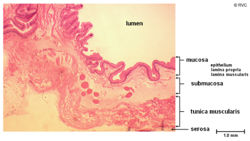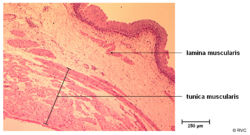Difference between revisions of "Urinary Bladder - Anatomy & Physiology"
| Line 13: | Line 13: | ||
==Anatomy== | ==Anatomy== | ||
| − | + | [[Image:bladhistoanat1.jpg|right|thumb|250px|<small><center>Histology cross section of a normal guinea pig bladder (© RVC 2008)</center></small>]] | |
| + | [[Image:bladhistoanat2.jpg|right|thumb|250px|<small><center>Histology cross section of a normal guinea pig bladder (© RVC 2008)</center></small>]] | ||
* It is a hollow, muscular organ | * It is a hollow, muscular organ | ||
* It is divided for descriptive purposes into three parts | * It is divided for descriptive purposes into three parts | ||
Revision as of 19:05, 20 August 2008
|
|
- The bladder is where urine is stored before being expelled by the body through the micturition reflex.
- Without a bladder urinary continence would be impossible.
Anatomy
- It is a hollow, muscular organ
- It is divided for descriptive purposes into three parts
- Cranial Pole
- Intermediate body
- Caudal neck
- Its wall comprises a muscle layer covered in an epithelium.
- Its size and posistion are determined by how full it is.
- When empty the bladder wall is wrinkled and thicker
- When full and distended the folds dissapear and the wall appears thinner
- The paired uteric folds are visible even when the bladder is full.
- They extend from the ureteral opening to the neck of the bladder
- Here they merge
- Forms the urethral crest - continues into the urethra
Muscles of the Bladder
The three muscular components of the bladder described below play a pivotal part in the micturition reflex.
Detrusor Muscle
Network of smooth muscle fibres within the bladder wall which are supplied by both parasympathetic and sympathetic nerves.
Parasympathetic Supply - Detrusor Muscle
- S1-S3
- Synapse in pelvic plexus or bladder wall
- Innvervate the detrusor muscle
- Action - excitatory
- Function - empty bladder
Sympathetic Supply - Detrusor Muscle
- L1-L4
- Syanpse in caudal mesenteric ganglion - bladder wall
- Receptor - beta
- Inhibitory action
- Allows bladder filling
Internal Urethral Sphincter
Its a thickening of the bladder musculature found at the neck of the bladder which is continous with the detrusor and is therefore smooth muscle. However unlike the detrusor its innervation is purely from sympathetic fibres.
Sympathetic Supply - Internal Urethral Sphincter
- L1-L4
- Synapse in caudal mesenteric ganglion
- Receptor - alpha
- Excitatory action
- Function - retain urine through increased urethral tone
External Urethral Sphincter
Unlike the internal sphincter the external sphincter is composed of striated muscle fibres which are under the voluntary control of the somatic nervous system
Somatic Motor Supply - External Urethral Sphincter
- S1-S2
- Pudendal Nerve
- No synapse
- Innervates the urethral skeletal muscle - external urethral sphincter
- Function is to retain urine
The Ligaments of the Bladder
- Two lateral ligaments
- Insert in the dorsal abdominal wall
- Within them are the residual umbilical vessels
- Median ligament
- Connects the bladder to pelvic floor and linea alba
Blood Supply, Innervation and Lymphatic Drainage
Blood Supply - Caudal vesicular artery
Sympathetic Innervation - Via hypogastric nerve from the caudal mesenteric ganglion
Parasympathetic Innervation - Pudendal nerve
Lymphatic Drainage - Iliosacral lymph nodes

